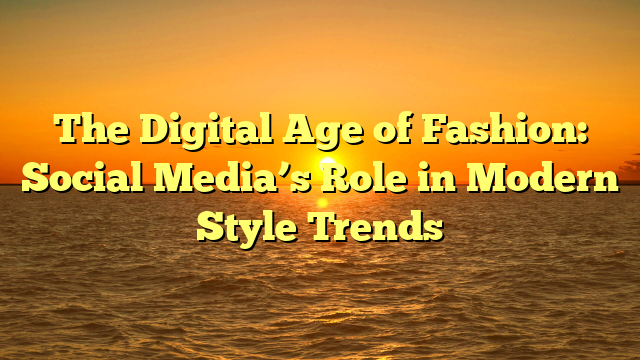
The fashion industry has always been dynamic, constantly evolving to reflect societal changes, but in the last decade, it has undergone a revolutionary transformation due to the rise of social media. Platforms like Instagram, the proliferation of influencer culture, and the booming e-commerce sector have radically altered the way people discover, consume, and engage with fashion. In the digital age, style trends are no longer dictated solely by high-end designers or magazine editors; instead, they are driven by influencers, online communities, and the accessibility of digital shopping.
One of the most significant changes in the fashion landscape has been the rise of influencers. These individuals, who amass large followings on platforms like Instagram, YouTube, and TikTok, have become key players in shaping fashion trends. Their ability to reach millions of people instantly has made them more influential than traditional celebrities in many cases. Influencers, often everyday people who curate their personal style and share their outfits, have democratized fashion. Their authenticity and relatability resonate with followers, making their style choices more aspirational and accessible than the polished, unattainable looks often associated with high-fashion runway shows.
Instagram, in particular, has played a central role in shaping modern fashion trends. With over a billion active users, Instagram has become the go-to platform for fashion inspiration. Users can scroll through an endless feed of street style, celebrity outfits, and curated looks from influencers, all while tagging brands and linking to e-commerce stores. The platform’s visual nature makes it a perfect match for fashion, where aesthetics play a central role. Instagram’s algorithm rewards content that generates engagement, pushing fashion brands and influencers to produce more visually striking, eye-catching content. Fashion brands, both large and small, now rely on Instagram as a primary marketing tool, using it to showcase new collections, launch collaborations, and directly interact with consumers.
In addition to influencers and Instagram, e-commerce has become a driving force in the digital age of fashion. Online shopping has seen explosive growth, especially in the wake of the COVID-19 pandemic, which forced many brick-and-mortar stores to close temporarily. E-commerce has made fashion more accessible than ever, allowing consumers to shop from virtually anywhere in the world. Major platforms like ASOS, Zara, and Amazon, as well as niche online boutiques, offer a vast array of clothing options, while new technologies like virtual try-ons and AI-driven recommendations enhance the shopping experience.
The convenience of shopping online has also led to the rise of fast fashion, where trends move from the runway to retail in a matter of weeks, rather than months. This has given consumers immediate access to the latest styles, but it has also sparked concerns about sustainability and ethical practices within the fashion industry. Despite these concerns, the speed and accessibility of e-commerce have changed the way people view fashion—trends are now seen as ever-changing, and consumers are constantly on the lookout for the next big thing.
The influence of influencers and social media has also shifted the power dynamics within the fashion industry. Historically, fashion trends were set by elite designers and institutions, but now, trends can be born from the grassroots level, as influencers and online communities shape what’s considered “cool.” Fashion is no longer confined to the pages of magazines or the runways of Paris and Milan; it’s on your smartphone, in your feed, and shared by the people you follow. This shift has led to greater diversity in the representation of style, with influencers from all walks of life—including different body types, ethnicities, and gender expressions—showcasing a wider range of looks.
However, this digital revolution also presents challenges. keongtogel to constantly share and update content has led to concerns about mental health, especially among younger followers who feel compelled to emulate influencers’ often unattainable lifestyles. The constant need for validation through likes, comments, and shares can create a cycle of comparison, sometimes leaving people feeling inadequate. Additionally, the fast-paced nature of digital fashion can fuel overconsumption, contributing to the environmental impact of the fashion industry.
Despite these challenges, the digital age has undoubtedly reshaped fashion in profound ways. Social media platforms like Instagram, the rise of influencers, and the growth of e-commerce have made fashion more inclusive, accessible, and dynamic than ever before. Trends no longer have to be dictated by traditional powerhouses; instead, they are born from the streets, shared through social media, and brought to life in online stores. The future of fashion will continue to be shaped by the digital world, where style is constantly evolving, and everyone has a voice in defining what’s on trend.





